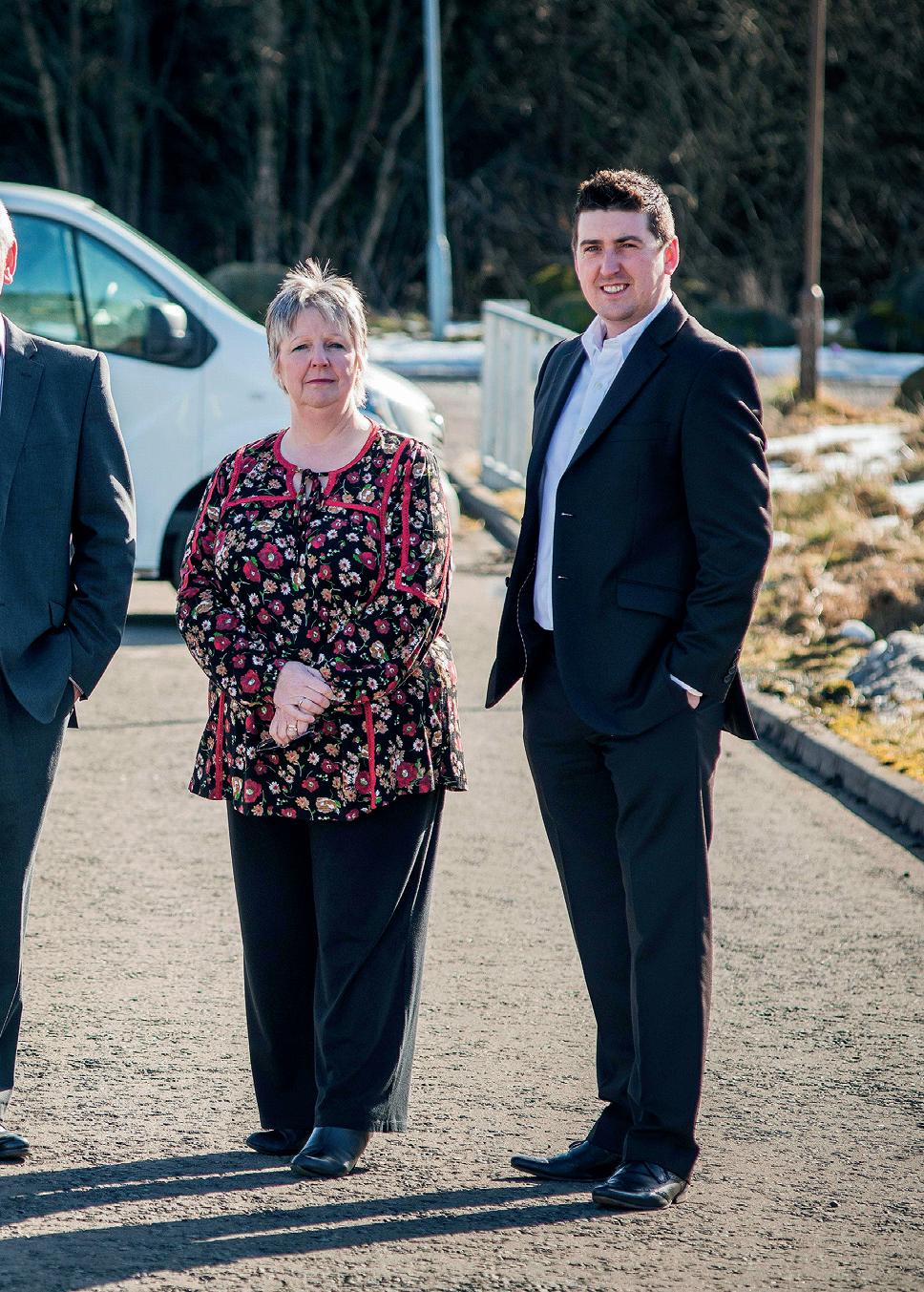
5 minute read
A shift in strategy to installing
Left to right: Stuart, John, Ian, Lorraine and Stephen Boyd of Boyd Brothers
85%

BOYD BROTHERS HAS INSTALLED INFRASTRUCTURE FOR 30 OUT OF THE 32 AUTHORITIES IN SCOTLAND, AND ESTIMATES IT HAS INSTALLED AROUND 85 PER CENT OF THE PUBLIC CHARGING INFRASTRUCTURE IN THE COUNTRY
THE BUSINESS CURRENTLY EMPLOYS 45 OPERATIVES, WITH A FURTHER 10 OFFICEBASED STAFF
Boyd Brothers HQ in Livingston
is still at an early stage. “Our infrastructure is still years away from people taking the gamble to go electric because they know there’s a safety net of having a charging point nearby, so we still have a lot of work to do,” he says. “Any place where people go are potential customers, so business parks, leisure centres, cinemas and shopping centres.” Th e fi rm has just fi nished a job at the Livingston Designer Outlet shopping centre, he adds.
Increasingly, the company’s reputation and client demands are taking the business out of its traditional Scottish base; to the extent that it is currently in the process of opening a second offi ce in Hemel Hempstead. Stephen says: “I think we picked the right place at the right time to be Scottish, but our customers are pulling us south.”
NEW GROUND
Th e EV work is also pulling the business into related areas, including developing its own civil division to cover the groundwork involved with installing the charging infrastructure.
It’s also setting up a utilities division, which it hopes will be fully operational by the end of the year. Th is would allow it to become an independent connection provider, able to carry out its own connections to the national grid network as well as the design and installation of substations. Th e plan is to take on work traditionally handled by distribution network operators, on both charging points and wind turbine projects.
Another growth area is charging hubs, eff ectively car parks where vehicles can recharge. Solar panels mounted on canopies over parking bays provide supplementary electricity, which is stored in energy storage units and then distributed through the charge points. Th e fi rm has already worked on a number of projects and is currently well underway with Dundee City Council’s Go Ultra Low city scheme.
Today, the company’s activities are mainly overseen by John, Stephen and Stuart, with John handling operations, Stephen the commercial side and Stuart about to take on the role of EV surveying manager. All three are qualifi ed electricians, having joined the business straight from school, and took on more responsibility in 2011 when Ian had a spell off work through ill-health. “When I came back, the management structure was in place, and I didn’t do anything to stop that,” says Ian. “I’m quite happy with it.”
Company Boyd Brothers Established 1967 Major projects Livingston Designer Outlet, Royal Mail, Scottish public charging infrastructure
30 out of 32
Th e business currently employs 45 operatives, with a further 10 offi ce-based staff , and is currently seeking to take on project managers, electricians and experienced ground workers as it looks to expand the business across the UK.
In the not-too-distant future, Ian and Lorraine are hoping to exit the business altogether, with the next generation taking over the full running of the business. “It’s the boys who will be taking on the mantle from there on in,” says Ian. “I don’t know what their intentions are but we need to keep growing with the market; it’s all been organic growth up to now and I’d like that to continue. But I’m immensely proud of everything, as would my father and brother be.”
John, meanwhile, is also hoping the business continues the steady growth it has seen since the shift in strategy. “We’re viewed as one of the leading contractors in this industry, so we want to continue leading the way in building that infrastructure,” he says. “It’s still very much in its infancy and hopefully as the industry grows we will grow with it.”
Investment in houses, schools and commercial premises has seen the construction sector thrive in Scotland. But concerns over skills, wages and late payment remain
BY ROB SHEPHERD
The construction industry makes a sizeable fi nancial contribution to Scotland’s gross domestic product, generating around £21.4 billion a year, according to fi gures from the Scottish government. It employs more than 170,000 people, and in the quarter to August 2017 the value of underlying project starts in Scotland grew by 29 per cent – the biggest rise in any part of the UK.
In 2007, the Scottish government set out an ambitious target of building 35,000 new homes every year, with a commitment to building 50,000 aff ordable homes by 2021. In 2017 it announced plans to further increase its investment in housing by nearly £140 million.
Newbuild activity is on the rise, and 19,598 new homes were started across all sectors in the year ending June 2017, an increase of 13 per cent or 2,188 homes on the previous year. Aff ordable
State of the nation
housing supply is increasing, with more than 70,000 aff ordable homes delivered in Scotland since 2007 – a total of 48,813 homes for social rent, including 8,819 council homes.
COMMERCIAL GAIN
Scotland accounts for just over 7 per cent of the value of commercial property in the UK, according to Scottish Property Federation fi gures. Glasgow is seeing signifi cant demand for high-quality premises, while supply in Edinburgh is at its lowest level since 2010. Th is is pushing rents up, and businesses are often unable to expand or move as a result.
Industrial premises represent 22 per cent of the total stock of commercial property in Scotland, and its industrial property market is attracting increasing investor and developer interest, as the current supply is insuffi cient for a market of this size. However, with infl ation outrunning monthly wage increases, a lack of disposable income for a signifi cant percentage of the population continues to have a negative eff ect on retailers.
PUBLIC PROPERTY
Annual Scottish public sector construction expenditure is around £4 billion, the Specialist Engineering Contractors’ Group Scotland estimates, and there has been signifi cant activity in the building of new schools, through the government’s £1.8 billion Schools for the Future programme. Th e government claims the programme, launched in 2009, will see the construction or refurbishment of 116 schools by March 2020, creating an estimated 11,000 construction jobs and 230 apprenticeships.
Within the healthcare sector, Frameworks Scotland 2 builds on the success of Frameworks Scotland, which saw 60 NHS facilities with a value of £462 million delivered. Th is national framework is an agreement with fi ve principal supply chain partners selected via an Offi cial Journal of the
European Union tender process for capital investment construction schemes across Scotland up to 2019.





